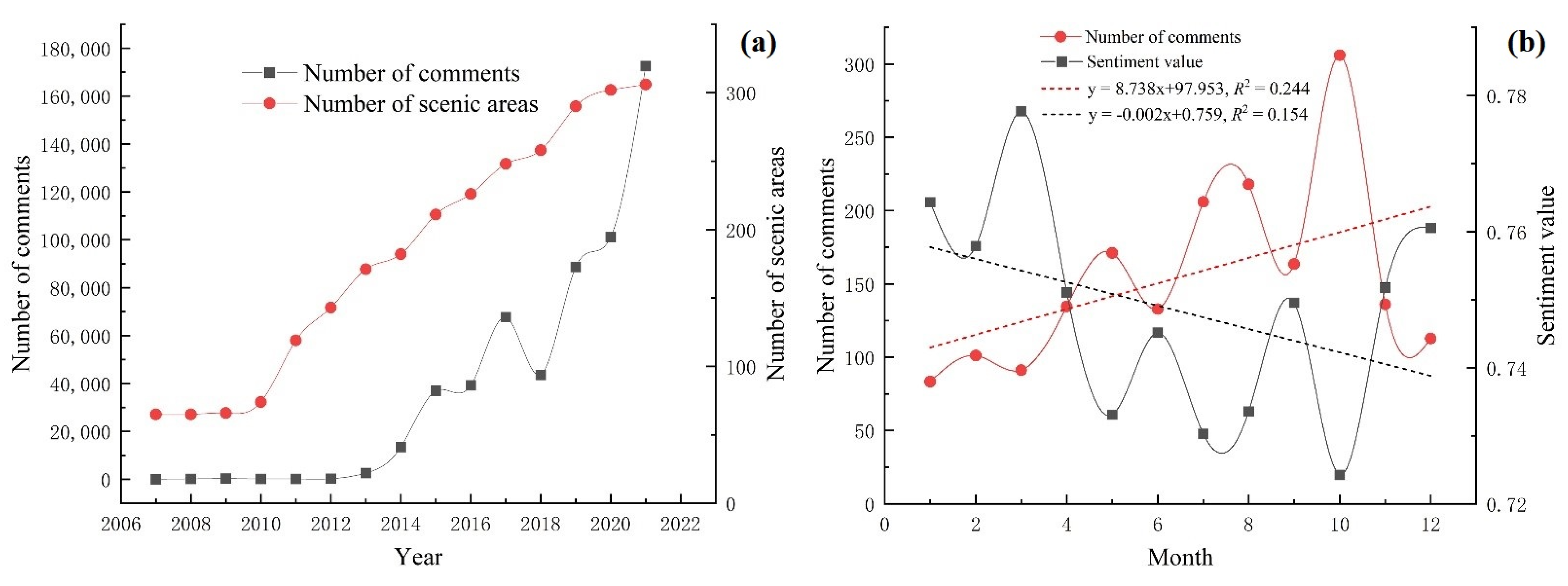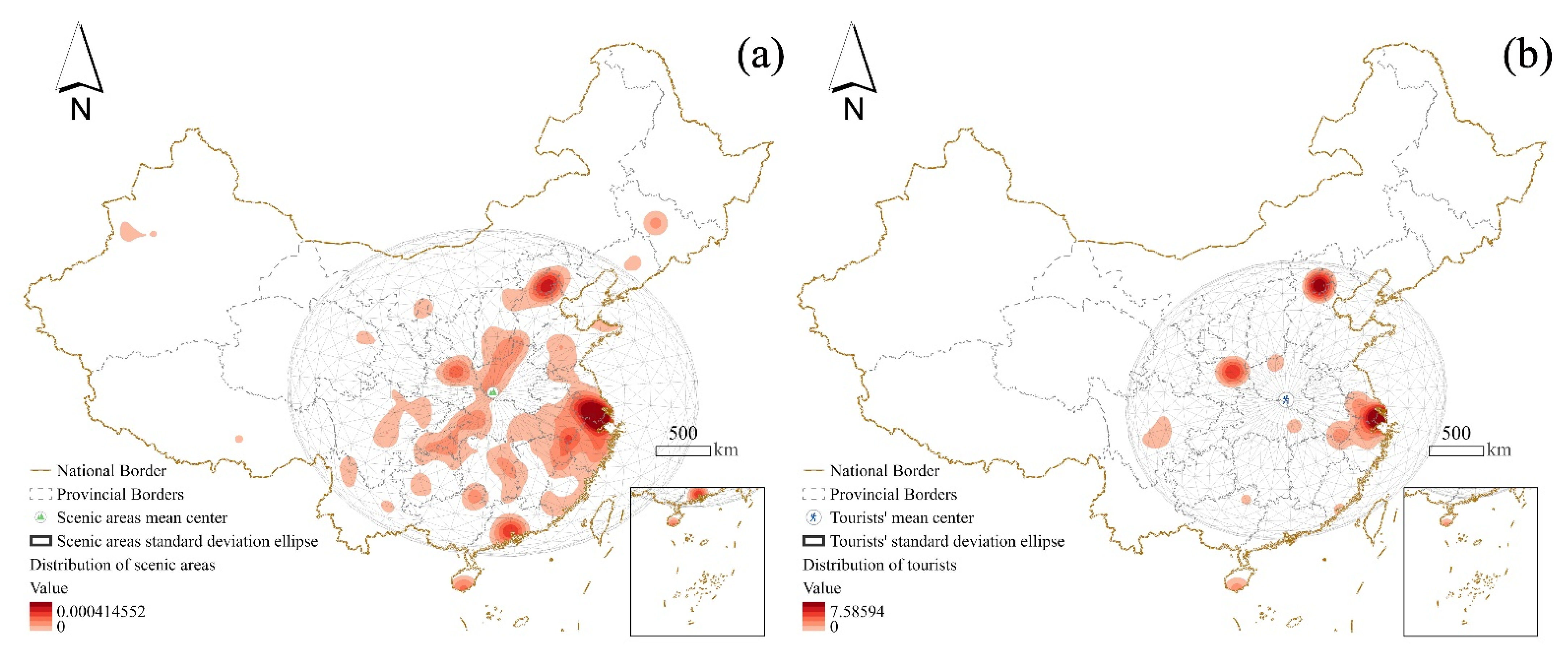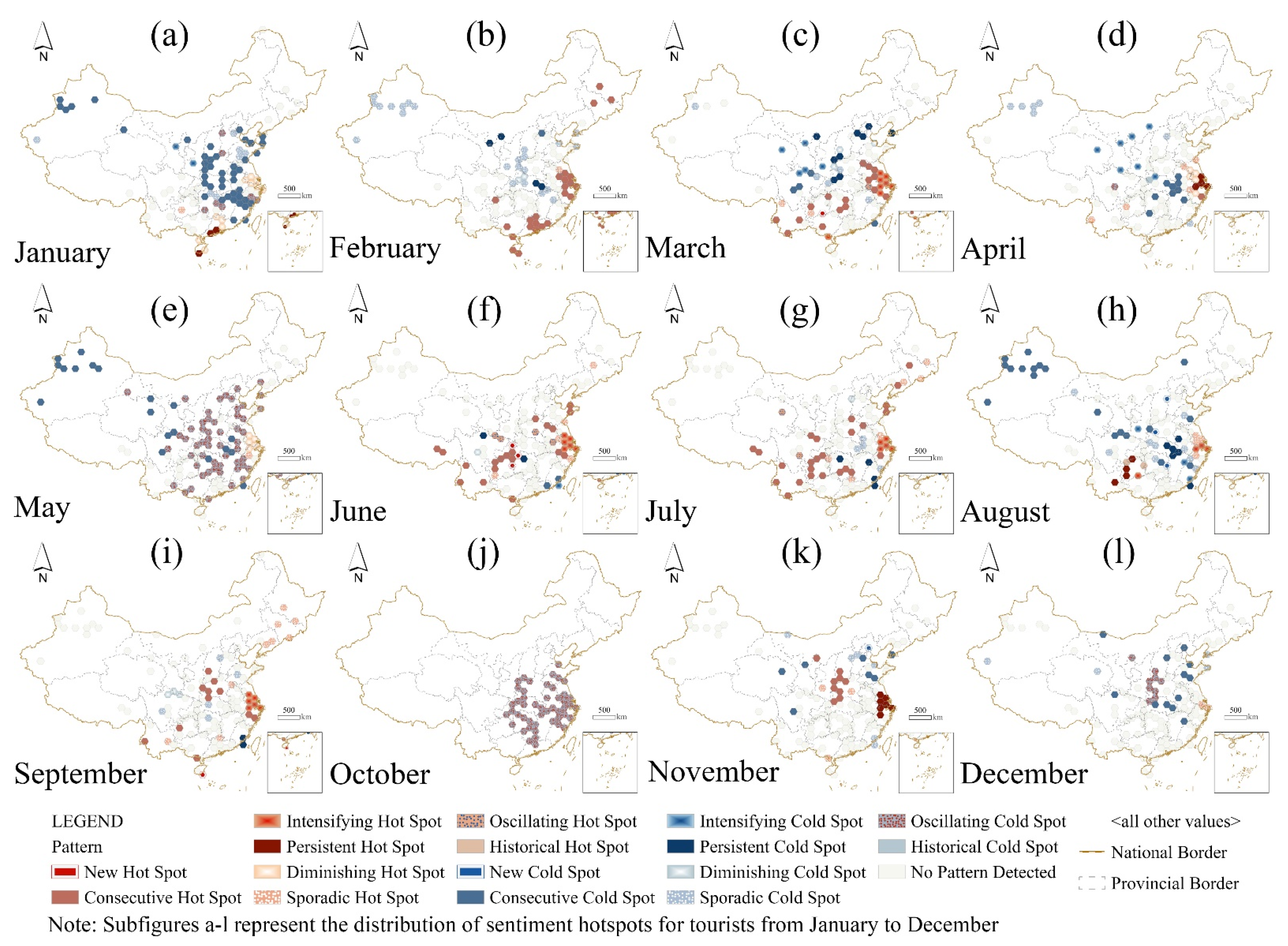Sensing Tourist Distributions and Their Sentiment Variations Using Social Media: Evidence from 5A Scenic Areas in China
Abstract
:1. Introduction
2. Related Work
2.1. Research Related to Scenic Areas
2.2. Research Related to Tourism Social Media
2.3. Research Related to Sentiment Analysis
3. Research Area, Data Sources, and Research Framework
3.1. Research Area
3.2. Data Sources
3.3. Research Framework
4. Methods
4.1. Sentiment Classification Based on SnowNLP
4.2. Spatial Analysis Methods
4.3. Cold Hot Pattern Mining
5. Results
5.1. SnowNLP Sentiment Classification Check
5.2. Tourist Distribution Characteristics and Sentiment Variations
5.2.1. Timing Analysis
5.2.2. Spatial Analysis
5.2.3. Sentiment Cold and Hot Variations
6. Discussions and Recommendations
6.1. Discussions
6.2. Suggestions
7. Conclusions
Author Contributions
Funding
Data Availability Statement
Acknowledgments
Conflicts of Interest
References
- Geng, S.; Zhang, H. High-Quality Development of China’s Tourism Industry: Strategic Mission, Power Factors and Promotion Path. Macroeconomics 2022, 01, 91–101. [Google Scholar] [CrossRef]
- Ming, Q.; Zheng, B. Research on the Construction of Driving System and Development Level Measurement of Tourism High-Quality Development in Mountain Scenic Area. J. Cent. China Norm. Univ. 2022, 56, 91–104. [Google Scholar] [CrossRef]
- Yu, Y.; Lang, M.; Zhao, Y.; Liu, W.; Hu, B. Tourist Perceived Value, Tourist Satisfaction, and Life Satisfaction: Evidence From Chinese Buddhist Temple Tours. J. Hosp. Tour. Res. 2021, 109634802110153. [Google Scholar] [CrossRef]
- Pietilä, M.; Fagerholm, N. Visitors’ Place-Based Evaluations of Unacceptable Tourism Impacts in Oulanka National Park, Finland. Tour. Geogr. 2016, 18, 258–279. [Google Scholar] [CrossRef]
- Liu, Y.; Bao, J.; Zhu, Y. Exploring emotion methods of tourism destination evaluation: A big-data approach. Geogr. Res. 2017, 36, 1091–1105. [Google Scholar]
- Marin, J.; Grijalvo, M.; Mundet, L. Can a Mature Sun & Beach Tourist DestinationChange Its Image Among Tourists?: The Case Study of Lloret de Mar. Tourism 2021, 69, 527–542. [Google Scholar] [CrossRef]
- Wang, P.; Hu, T.; Gao, F.; Wu, R.; Guo, W.; Zhu, X. A Hybrid Data-Driven Framework for Spatiotemporal Traffic Flow Data Imputation. IEEE Internet Things J. 2022, 1. [Google Scholar] [CrossRef]
- Zhang, Y.; Zhang, F.; Chen, N. Migratable Urban Street Scene Sensing Method Based on Vision Language Pre-Trained Model. Int. J. Appl. Earth Obs. Geoinf. 2022, 113, 102989. [Google Scholar] [CrossRef]
- Song, S.; Kawamura, H.; Uchida, J.; Saito, H. Determining Tourist Satisfaction from Travel Reviews. Inf. Technol. Tour. 2019, 21, 337–367. [Google Scholar] [CrossRef]
- Zhang, Y.; Zheng, X.; Helbich, M.; Chen, N.; Chen, Z. City2vec: Urban Knowledge Discovery Based on Population Mobile Network. Sustain. Cities Soc. 2022, 85, 104000. [Google Scholar] [CrossRef]
- Fazzolari, M.; Petrocchi, M. A Study on Online Travel Reviews through Intelligent Data Analysis. Inf. Technol. Tour. 2018, 20, 37–58. [Google Scholar] [CrossRef]
- Hu, X.; Yang, Y. What Makes Online Reviews Helpful in Tourism and Hospitality? A Bare-Bones Meta-Analysis. J. Hosp. Mark. Manag. 2021, 30, 139–158. [Google Scholar] [CrossRef]
- Su, L.; Yang, Q.; Swanson, S.R.; Chen, N.C. The Impact of Online Reviews on Destination Trust and Travel Intention: The Moderating Role of Online Review Trustworthiness. J. Vacat. Mark. 2021, 135676672110632. [Google Scholar] [CrossRef]
- Chen, W.; Xu, Z.; Zheng, X.; Yu, Q.; Luo, Y. Research on Sentiment Classification of Online Travel Review Text. Appl. Sci. 2020, 10, 5275. [Google Scholar] [CrossRef]
- Cong, L.; He, J. An Emotional Analysis of Tourists in Wildlife Tourism Scenic Spots——A Case Study in Chimelong Safari Park. Tour. Trib. 2020, 35, 12. [Google Scholar]
- Dang, N.; Xiao, H.; Li, W. Empirical research on the influencing factors of tourists’pro-environment behavior:based on the dual perspectives of emotion and cognition. Hum. Geogr. 2021, 36, 185–192. [Google Scholar] [CrossRef]
- Bruno, S.; Yang, C.; Tian, W.; Xie, Z.; Shao, Y. Exploring the Characteristics of Tourism Industry by Analyzing Consumer Review Contents from Social Media: A Case Study of Bamako, Mali. Geo-Spat. Inf. Sci. 2019, 22, 214–222. [Google Scholar] [CrossRef]
- Taecharungroj, V.; Mathayomchan, B. Analysing TripAdvisor Reviews of Tourist Attractions in Phuket, Thailand. Tour. Manag. 2019, 75, 550–568. [Google Scholar] [CrossRef]
- Baniya, R.; Dogru-Dastan, H.; Thapa, B. Visitors’ Experience at Angkor Wat, Cambodia: Evidence from Sentiment and Topic Analysis. J. Herit. Tour. 2020, 1–14. [Google Scholar] [CrossRef]
- Fang, C.; Zhang, G.; Xue, D. High-quality development of urban agglomerations in China and construction of science and technology collaborative innovation community. Acta Geogr. Sin. 2021, 76, 2898–2908. [Google Scholar]
- Zhang, G.; Wang, Y.; Wang, Y.; Cao, Y.; Zhou, C. The Spatio-temporal Evolution and Mechanism of the Coordination Between Quality and Quantity of Economic Growth in Chinese Urban Agglomerations. Sci. Geogr. Sin. 2021, 41, 2075–2086. [Google Scholar] [CrossRef]
- Zhou, J. Region-wide Tourism under the Strategy of Regional Coordinated Development:An Exploration of the Paradigm of Interaction of Eastern Guangdong Urban Agglomeration. Soc. Sci. 2021, 36, 50–55. [Google Scholar]
- Qiu, Y.; Yin, J.; Zhang, T.; Du, Y.; Zhang, B. Spatiotemporal Dynamic Analysis of A-Level Scenic Spots in Guizhou Province, China. ISPRS Int. J. Geo-Inf. 2021. [Google Scholar] [CrossRef]
- Liu, M.; Hao, W. The Spatial Distribution and Influence Factors of A-Level Scenic Spots in Shanxi Province. Econ. Geogr. 2020, 40, 10. [Google Scholar]
- Zhang, H.; Shi, T.; Bao, H. The Spatial Structure Characteristics of China’s 5A-Level Tourist Attractions. J. Huaqiao Univ. Soc. Sci. 2019, 80–90. [Google Scholar] [CrossRef]
- Cheng, Y.; Hou, Z.; Chen, J.; Economics, S.O.; University, P.; School, H.B.; University, P.; School, B.; Technology, U.O. Sydney Distribution Features and Economic Effect of National 5A Tourist Attractions in China. Areal Res. Dev. 2015. [Google Scholar]
- García-Palomares, J.C.; Gutiérrez, J.; Mínguez, C. Identification of Tourist Hot Spots Based on Social Networks: A Comparative Analysis of European Metropolises Using Photo-Sharing Services and GIS. Appl. Geogr. 2015, 63, 408–417. [Google Scholar] [CrossRef]
- Gaładyk, P.; Podhorodecka, K. Tourist Attractions and the Location of Campsites in Western Australia. Curr. Issues Tour. 2021, 24, 2144–2166. [Google Scholar] [CrossRef]
- Wang, P.; Zhang, T.; Zheng, Y.; Hu, T. A Multi-View Bidirectional Spatiotemporal Graph Network for Urban Traffic Flow Imputation. Int. J. Geogr. Inf. Sci. 2022, 36, 1231–1257. [Google Scholar] [CrossRef]
- Fang, B.; Ye, Q.; Kucukusta, D.; Law, R. Analysis of the Perceived Value of Online Tourism Reviews: Influence of Readability and Reviewer Characteristics. Tour. Manag. 2016, 52, 498–506. [Google Scholar] [CrossRef]
- Xiao, X.; Fang, C.; Lin, H.; Chen, J. A Framework for Quantitative Analysis and Differentiated Marketing of Tourism Destination Image Based on Visual Content of Photos. Tour. Manag. 2022, 93, 104585. [Google Scholar] [CrossRef]
- Liang, B. Development of Rural Community-Based Tourism with Local Customs from the View of Consumer Satisfaction. Ann. Oper. Res. 2021, 1–17. [Google Scholar] [CrossRef]
- Hsieh, H.-P.; Li, C.-T. Composing Traveling Paths from Location-Based Services. Proc. Int. AAAI Conf. Web Soc. Media 2012, 6, 618–619. Available online: https://ojs.aaai.org/index.php/ICWSM/article/view/14228 (accessed on 1 August 2022).
- Yan, R.; Xia, Z.; Xie, Y.; Wang, X.; Song, Z. Research on Sentiment Classification Algorithms on Online Review. Complexity 2020, 2020. [Google Scholar] [CrossRef]
- Baziotis, C.; Pelekis, N.; Doulkeridis, C. Datastories at Semeval-2017 Task 4: Deep Lstm with Attention for Message-Level and Topic-Based Sentiment Analysis. In Proceedings of the 11th International Workshop on Semantic Evaluation (SemEval-2017), Vancouver, BC, Canada, 3–4 August 2017; pp. 747–754. Available online: https://aclanthology.org/S17-2126/ (accessed on 1 August 2022).
- Wang, H.W.; Zheng, L.J.; Yin, P.; He, S.Y. Classification of Sentimental Polarity for Chinese Online Reviews Based on Sentence Level Sentiment. J. Manag. Sci. China 2013, 16, 64–74. [Google Scholar]
- Bravo-Marquez, F.; Khanchandani, A.; Pfahringer, B. Incremental Word Vectors for Time-Evolving Sentiment Lexicon Induction. Cogn. Comput. 2022, 14, 425–441. [Google Scholar] [CrossRef]
- Ahmad, M.; Aftab, S.; Bashir, M.S.; Hameed, N.; Ali, I.; Nawaz, Z. SVM Optimization for Sentiment Analysis. Int. J. Adv. Comput. Sci. Appl. 2018, 9. [Google Scholar] [CrossRef]
- Mathapati, S.; Nafeesa, A.; Manjula, S.H.; Venugopal, K.R. OTAWE-Optimized Topic-Adaptive Word Expansion for Cross Domain Sentiment Classification on Tweets. In Advances in Machine Learning and Data Science; Springer: Berlin/Heidelberg, Germany, 2018; pp. 213–224. [Google Scholar]
- Yin, D.; Meng, T.; Chang, K.-W. Sentibert: A Transferable Transformer-Based Architecture for Compositional Sentiment Semantics. arXiv 2020, arXiv:2005.04114. [Google Scholar]
- Dwivedi, R.K.; Aggarwal, M.; Keshari, S.K.; Kumar, A. Sentiment Analysis and Feature Extraction Using Rule-Based Model (RBM). In Proceedings of the International Conference on Innovative Computing and Communications, New Delhi, India, 5–6 May 2018; pp. 57–63. [Google Scholar]
- Zhang, B.; Xiao, P.; Yu, X. The Influence of Prosocial and Antisocial Emotions on the Spread of Weibo Posts: A Study of the COVID-19 Pandemic. Discrete Dyn. Nat. Soc. 2021, 2021. [Google Scholar] [CrossRef]
- Liu, C.; Chen, Y.; Jian, Y.; Dong, R. Measurement of the driving capacity of tourism industry on indirect employment and its spatio-temporal differences in China. Acta Geogr. Sin. 2022, 77, 918–935. [Google Scholar]
- Lin, Y.X.; Lin, B.S.; Chen, M.H.; Su, C.H.J. 5A Tourist Attractions and China’s Regional Tourism Growth. Asia Pac. J. Tour. Res. 2020, 25, 524–540. [Google Scholar] [CrossRef]
- Tian, L.; Pu, W.; Su, C.-H.; Chen, M.-H.; Lin, Y.-X. Asymmetric Effects of China’s Tourism on the Economy at the City Level: A Moderating Role of Spatial Disparities in Top Level Tourist Attractions. Curr. Issues Tour. 2021, 1–17. [Google Scholar] [CrossRef]
- Chi, M.; Pan, M.; Wang, W. A Cross-Platform Comparative Study of Reviews on Sharing Accommodation and Hotels Reservation Platform: Combined with LDA-SNA and Sentiment Analysis. Libr. Inf. Serv. 2021, 65, 107. [Google Scholar]
- Zhang, J.; Zheng, Z.; Zhang, L.; Qin, Y.; Duan, J.; Zhang, A. Influencing Factors of Environmental Risk Perception during the COVID-19 Epidemic in China. Int. J. Environ. Res. Public Health 2021, 18, 9375. [Google Scholar] [CrossRef] [PubMed]
- Zhang, C.; Ma, X.; Zhou, Y.; Gao, R. Analysis of Public Opinion Evolution in COVID-19 Pandemic from a Perspective of Sentiment Variation. J. Geo-Inf. Sci. 2021, 23, 341–350. [Google Scholar]
- Zhu, Y.; Jing, C.; Fu, J.; Du, M.; Zhou, L. Analysis of Space-Time Pattern of Robbery Crime Based on Space-Time Cube. Sci. Surv. Mapp. 2019, 9, 132–138. [Google Scholar]
- Park, Y.M.; Kearney, G.D.; Wall, B.; Jones, K.; Howard, R.J.; Hylock, R.H. COVID-19 Deaths in the United States: Shifts in Hot Spots over the Three Phases of the Pandemic and the Spatiotemporally Varying Impact of Pandemic Vulnerability. Int. J. Environ. Res. Public. Health 2021, 18, 8987. [Google Scholar] [CrossRef]
- Purwanto, P.; Utaya, S.; Handoyo, B.; Bachri, S.; Astuti, I.S.; Utomo, K.S.B.; Aldianto, Y.E. Spatiotemporal Analysis of COVID-19 Spread with Emerging Hotspot Analysis and Space–Time Cube Models in East Java, Indonesia. ISPRS Int. J. Geo-Inf. 2021, 10, 133. [Google Scholar] [CrossRef]
- Allen, M.J.; Allen, T.R.; Davis, C.; McLeod, G. Exploring Spatial Patterns of Virginia Tornadoes Using Kernel Density and Space-Time Cube Analysis (1960–2019). ISPRS Int. J. Geo-Inf. 2021, 10, 310. [Google Scholar] [CrossRef]
- Böhm, J.; Möller, G.; Schindelegger, M.; Pain, G.; Weber, R. Development of an Improved Empirical Model for Slant Delays in the Troposphere (GPT2w). GPS Solut. 2015, 19, 433–441. [Google Scholar] [CrossRef]
- Cheng, S.; Zhang, B.; Peng, P.; Yang, Z.; Lu, F. Spatiotemporal Evolution Pattern Detection for Heavy-Duty Diesel Truck Emissions Using Trajectory Mining: A Case Study of Tianjin, China. J. Clean. Prod. 2020, 244, 118654. [Google Scholar] [CrossRef]
- Qi, Z.; Dehe, X.; Yan, D. Spatio-Temporal Pattern Mining of the Last 40 Years of Drought in China Based on SPEI Index and Spatio-Temporal Cube. Agric. Res. Arid Areas 2021, 39, 8. [Google Scholar]
- Ji, X.; Li, Y.; Cao, G. Time-space Pattern Evolution and Optimal Regulation of Scenic Crowding. Areal Res. Dev. 2021, 40, 95–100. [Google Scholar]
- Tarver, R.; Cohen, K.; Klyve, D.; Liseki, S. Sustainable Safari Practices: Proximity to Wildlife, Educational Intervention, and the Quality of Experience. J. Outdoor Recreat. Tour. 2019, 25, 76–83. [Google Scholar] [CrossRef]
- Yuan, L.; Yang, Y.; Wang, J. A Study on the development characteristics of the national 5A tourist attractions in China. J. Huazhong Norm. Univ. Sci. 2014, 48, 301–306. [Google Scholar] [CrossRef]
- Li, H.; Li, D.; Dong, X.; Xu, N. Spatial Patterns of 5A-Level Tourist Attractions and Their Nework Attention Degrees in China. J. Arid Land Resour. Environ. 2019, 10. [Google Scholar]
- Zhang, C.; Zhang, Z. Research on Spatial Distribution and Influencing Factors of Tourist Attractions in China’s Three Major Urban Agglomerations. China Anc. City 2021, 35, 15–22. [Google Scholar] [CrossRef]
- Ettema, D.; Friman, M.; Olsson, L.E.; Gärling, T. Season and Weather Effects on Travel-Related Mood and Travel Satisfaction. Front. Psychol. 2017, 8. [Google Scholar] [CrossRef]
- St-Louis, E.; Manaugh, K.; van Lierop, D.; El-Geneidy, A. The Happy Commuter: A Comparison of Commuter Satisfaction across Modes. Transp. Res. Part F: Traffic Psychol. Behav. 2014, 26, 160–170. [Google Scholar] [CrossRef]
- Padilla, J.J.; Kavak, H.; Lynch, C.J.; Gore, R.J.; Diallo, S.Y. Temporal and Spatiotemporal Investigation of Tourist Attraction Visit Sentiment on Twitter. PLoS ONE 2018, 13, e0198857. [Google Scholar] [CrossRef]
- Chen, M.M.; Yu, P.; Zhang, Y.; Wu, K.; Yang, Y. Acoustic Environment Management in the Countryside: A Case Study of Tourist Sentiment for Rural Soundscapes in China. J. Environ. Plan. Manag. 2021, 1–23. [Google Scholar] [CrossRef]
- Cheng, Z.; Jin, M.; Jiang, Q. Research into the Competitiveness of Scenic Areas from the Perspective of Tourists: A Case Study of the Jiuzhai Valley. Emerg. Mark. Financ. Trade 2019, 1–9. [Google Scholar] [CrossRef]
- Huang, J.; Obracht-Prondzynska, H.; Kamrowska-Zaluska, D.; Sun, Y.; Li, L. The Image of the City on Social Media: A Comparative Study Using “Big Data” and “Small Data” Methods in the Tri-City Region in Poland. Landsc. Urban Plan. 2021, 206, 103977. [Google Scholar] [CrossRef]







| Comment Text | Name of the Scenic Area | Scenic POI | Time |
|---|---|---|---|
| “The view was so beautiful that I didn’t expect it to rain on the mountain…” | Black Valley | 115.817318, 28.660664 | 14 August 2021 |
| “Well worth going, picturesque, natural oxygen bar…” | Yinxu | 116.003495, 28.703978 | 21 July 2021 |
| “Now, in fact, the admission fee is still quite expensive…” | Mount Huangshan | 115.979817, 28.687144 | 23 March 2020 |
| Classification Method | Accuracy | Category | Precision | Recall | F1 |
|---|---|---|---|---|---|
| SnowNLP | 0.83 | Negative | 0.74 | 0.90 | 0.81 |
| Positive | 0.92 | 0.78 | 0.84 | ||
| Optimized SnowNLP | 0.89 | Negative | 0.85 | 0.92 | 0.88 |
| Positive | 0.93 | 0.86 | 0.89 |
| Directional Distribution | CenterX | CenterY | XstdDist | YstdDist | Area (Polyhedron) |
|---|---|---|---|---|---|
| scenic areas Number of comments | 124.897 | 38.799 | 1834.248 | 1499.629 | 17,195,492.797 |
| 126.538 | 38.185 | 1482.034 | 1268.155 | 11,749,068.049 |
Publisher’s Note: MDPI stays neutral with regard to jurisdictional claims in published maps and institutional affiliations. |
© 2022 by the authors. Licensee MDPI, Basel, Switzerland. This article is an open access article distributed under the terms and conditions of the Creative Commons Attribution (CC BY) license (https://creativecommons.org/licenses/by/4.0/).
Share and Cite
Wang, J.; Xia, Y.; Wu, Y. Sensing Tourist Distributions and Their Sentiment Variations Using Social Media: Evidence from 5A Scenic Areas in China. ISPRS Int. J. Geo-Inf. 2022, 11, 492. https://doi.org/10.3390/ijgi11090492
Wang J, Xia Y, Wu Y. Sensing Tourist Distributions and Their Sentiment Variations Using Social Media: Evidence from 5A Scenic Areas in China. ISPRS International Journal of Geo-Information. 2022; 11(9):492. https://doi.org/10.3390/ijgi11090492
Chicago/Turabian StyleWang, Jingbo, Yu Xia, and Yuting Wu. 2022. "Sensing Tourist Distributions and Their Sentiment Variations Using Social Media: Evidence from 5A Scenic Areas in China" ISPRS International Journal of Geo-Information 11, no. 9: 492. https://doi.org/10.3390/ijgi11090492
APA StyleWang, J., Xia, Y., & Wu, Y. (2022). Sensing Tourist Distributions and Their Sentiment Variations Using Social Media: Evidence from 5A Scenic Areas in China. ISPRS International Journal of Geo-Information, 11(9), 492. https://doi.org/10.3390/ijgi11090492






